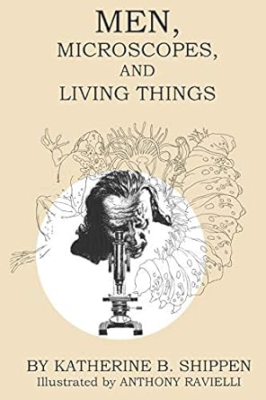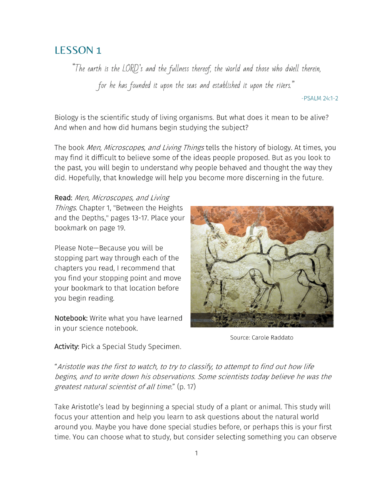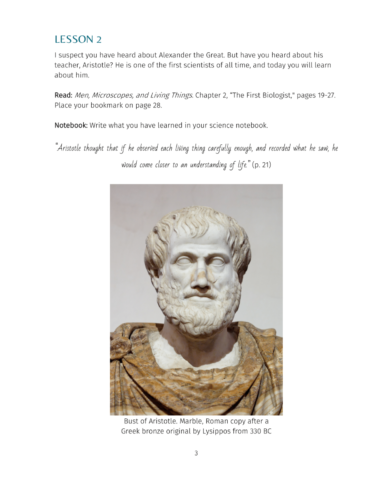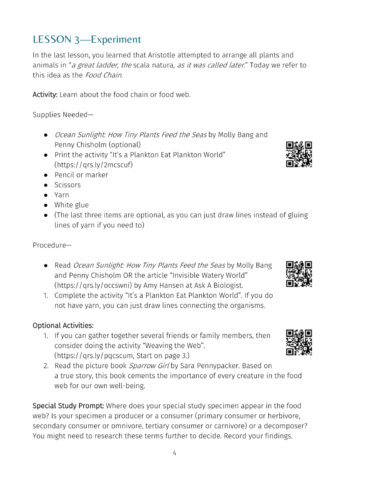In this Form 3-4 (grade 7-9) study guide, students will be introduced to the principles and tools of biological study, food webs, life processes, some anatomy, adaptation, natural selection, extinction, cell theory, simple genetics, and reproduction.
This science study guide provides a comprehensive introduction to each lesson, along with reading assignments from the spine text, narration prompts, and open discussion questions. It also features experiments directly related to the reading, as well as optional supplemental activities such as current events, videos, and suggested articles for deeper exploration when time allows. Additionally, a link to an exam for each course is included in the introductory material.
The Form 3+ guides are written directly to the student, allowing them to work independently. Parents and teachers must provide the necessary materials (outlined in the supply list found in the introductory material) and review the student’s notebooks and oversee their progress to ensure the lessons are completed.
- Pages: 61
- Prerequisites: none
- This course would also work well for a Form 4 (grade 9) student. While the reading level of Men, Microscopes, and Living Things is relatively easy, the quality of the material is worth reading at any age.
Spine Text
The study guide accompanies the living book Men, Microscopes, and Living Things by Katherine B. Shippen (Living Library Press, 2016, ISBN: 0692746153), which must be purchased separately.
- 183 pages, 18 chapters
- Reading Level: grade 6 and up
- Newbery Winner in 1956
- Note: Because this book was written in 1955, you might assume that the ideas are out of date. However, because it addresses the history of biology—its foundational ideas—it is not outdated. To cover the discoveries that have happened since 1955, primarily in the areas of cell theory and genetics, we will use supplementary resources.
Katherine Binney Shippen (1892-1980) was a young girl from New England who spent her time much as you may have. She ‘swum and paddled and picked berries, had been close to rabbits and squirrels, the green grass snakes and the big spiders that built their nests among the blackberry bushes’.
She grew to be a lover of people and languages, traveling much and adventuring far. She collected stories of people and was an avid researcher in the libraries. Ms. Shippen became a history teacher and then the curator of social studies at the Brooklyn Children’s Museum.
Her lectures were particular favorites among children of all ages. She found their questions to be so probing and their appetite for knowledge so great that she began to write books to tell stories in answer to their questions.
Ms. Shippen published 21 books, many of them award winning and published in other languages as well. Men, Microscopes, and Living Things won several prestigious awards, including a Newbery Honor in 1956. She saw all of life as beautiful and exciting and wanted its stories to not be forgotten but desired to share them with all. —Michele Jahncke (source)
Other Necessary Items to Complement This Course
- Review the Supply List for this course.
Schedule:
This study guide includes 33 lessons, each requiring approximately 30-40 minutes. You can either schedule it:
- Three times a week for 11 weeks allowing for exams during the 12th week, or
- Once a week for an entire year, allowing time for exams at the end of each term, and including other science subjects on the other days of the week.
We have started your guide and I think we’re going to love it! My pharmacist husband was very impressed with it!
—Robin, Children’s Legacy Library
After struggling through a few Charlotte Mason style science books on our own, I knew we were floundering and needed some help making these books come alive and interactive. I bought the biology curriculum and we have actually enjoyed our readings and LOVED the experiments and related activities. We do it together as a family and we now look forward to our science lesson three times a week.
—Allison S.
Sample Lessons:
A digital version can be purchased below, but the paperback copies of this study guide must be purchased on Amazon.
The study guide includes religious content, though the accompanying spine text does not. If you require a secular version, please choose that option below.
SMH offers discounted prices for Co-Op and Schools. If you are purchasing for Co-Ops, please refer to this page. For School License, please refer to this page.
Reviews
My freshman and 8th grader both did this. I prepped all the material at the beginning of the term and marked if I wanted them to do any “optional” materials. After that it was pretty hands off for me besides inspecting what was expected (checking to make sure work was done). I read the spine text and learned quite a bit of history.
Disclaimer: I’ve read through the guide but have not yet used it with my kids. In my perusal of it, I think the activities look less rigorous than those in the Form 3 Physics guide, and less conducive to doing in a group. I was disappointed to see only one (optional) microscope activity, as I was hoping this guide would be more microscope-heavy. I do understand not everyone has access to a microscope, but I may end up using a different book/guide for Form 3 biology, or combining this with something else.
This was such a fun book to read and the study guide was very helpful for planning the reading and narrating. SMH guides have been our go to for science for years!
You must log in to submit a review.






